Have you ever wondered if it’s worth your time to use a foam roller as a runner? I have, especially when sitting on a spot that’s super tight and painful!
“Find a place inside where there’s joy, and the joy will burn out the pain.” –Joseph Campbell!
I’m fairly certain foam rollers weren’t around in Joseph Campbell’s time…but the point still applies. You gotta focus on the outcome to get through a little time on the roller.
That is, if you should be foam rolling at all!
A lot of us have been using the foam roller all wrong, and instead of making things better, we’re perpetuating injuries and stressing out our bodies. It’s important to understand what’s really happening when we foam roll and then use it appropriately.
In particular, I want to ensure we stop beating up our IT bands, as that’s the biggest injury I am asked about.
So let’s dive into more about why we’re foam rolling and how to use it correctly as a runner.
What is Foam Rolling?
Foam rolling (also referred to as “self-myofascial release”) is a form of self-massage that people often use to release muscle tightness or trigger points. Using a cylindrical foam roller, you apply pressure to specific points on their body, rolling back and forth to massage the muscles.
We now know that much of what’s happening is a relaxation of your Central Nervous System.
Stretching does not send the same signals to your brain, so foam rolling specifically can help to relax tight muscles.
What does foam rolling do?
This process can help increase blood flow and circulation to the soft tissues in major muscle groups, improving flexibility and reducing muscle soreness. Again the main benefits, appear to come from helping the body to relax and release tension.
That relaxation allows increased blood flow and allows us to work on range of motion or move with less stiffness.
It’s a common practice among athletes and fitness enthusiasts, and it can be an essential part of a warm-up or cool-down routine in physical training. Even if you’re not an athlete, foam rolling can still be beneficial for everyday aches and pains.
How often should I foam roll?
Daily. I know that sounds like a lot, but if you foam roll before every run you’re both warming up the muscles and breaking up adhesions to keep you running injury free.
Also, by working those muscles daily you will quickly find it becomes less painful.
What is Fascia?
Often when people talk about foam rolling, they mention that it breaks up fascia. Which we now know may not be exactly correct, but let’s explain this idea so you understand it.
Fascia is a form of connective tissue that wraps and bundles muscles (myo) together. Myofascial adhesions can develop through stress, training, overuse, underuse, movement imbalances and injuries.
The muscle adhesions can cause weakness due to an inability to fully function, which leads to muscle imbalances and the body trying to correct for these.
Think of it like the white skin around an orange! It gives structure, but isn’t stiff.
What Are the Benefits of Foam Rolling for Runners?
From preventing injuries to reducing muscle soreness, there are a number of benefits that come with foam rolling for runners—IF you do it correctly.
Range of Motion
One study showed that foam rolling increased range of motion by 4.3%, which of course, leads to better stride and flexibility as runners.
Pre-Exercise Warmup
It’s a fantastic way to wake up the muscles and increase blood flow before your workout, which ensures your muscles react better. I use it simply to feel a little be less stiff.
Injury Prevention
Regular foam rolling can help identify tight spots and imbalances in the muscles, potentially preventing injuries. Addressing these issues early can lead to a more balanced body, reducing the risk of strains and overuse injuries.
Increased Oxygen Flow to Muscles
The pressure created by the foam roller increases blood flow to the targeted areas. Better circulation means more oxygen and nutrients are delivered to the muscles, promoting quicker healing and reducing fatigue.
Less Muscle Soreness
A 2019 review in Frontiers concluded that foam rolling does accelerate recovery after strength. Again this seems to be due to relaxing the CNS and allowing recovery to begin more quickly.
After a long run or intense workout, muscles can become stiff and sore, foam rolling provides a method of helping the body to relax and get out of that stressed state.
Want to understand more about the science behind rolling? Checkout our Tread Lightly show:
Should You Do Foam Rolling Before Running?
You can use a foam roller both before and after a run as part of your regular routine.
Foam rolling before a run can increase blood flow and loosen up the muscles. This leads to enhanced flexibility and range of motion, preparing your body for a great run.
It helps in warming up the muscles, reducing stiffness, and can contribute to a more efficient and comfortable run. A shorter session focusing on key areas like calves, hamstrings, and quads is usually sufficient.
Remember that before a run you are not holding on a spot, it’s continual movement.
Is It Better to Stretch or Foam Roll After Running?
The truth is that science doesn’t show you need to do either immediately after running.
Post run you should walk around for a bit to allow the heart rate to return to normal and you should focus on your nutrition, but when you spend time rolling or stretching is up to you.
As for which is better? It depends on what feels good to you! I love these post run stretches to help me slow down, relax and they simply feel good.
But foam rolling is sending that relaxation signal to the brain which relieves muscle tension in those trigger points, and aids in the removal of waste products like lactic acid. This reduces muscle soreness and speeds up the recovery process.
Should Foam Rolling Hurt?
As with running, discomfort is ok, but pain is bad. On a scale of 1-10, stop before you hit an 8.
As with physical therapy, you may feel discomfort at the time which is designed for long term healing. More pain is not better though!
The more consistently you roll {a few times a week} the less knots you will have and the less painful in general it will be over time.
Top Tips for Foam Rolling
#1 Stop Foam Rolling Your IT Band
Contrary to popular belief, your IT Band is not evil and does not need to be beaten into submission.
In fact, you really shouldn’t be using the roller right along your IT Band when it’s inflamed at all.
Read a lot more on this topic!
You can’t relax the IT Band, that’s a fallacy. Its tightness is caused by other muscles, from the glutes to misaligned hips.
What should you do instead?
- Work on activating the glutes while running
- Stretch the hip flexors
- Roll the thigh, the inner thigh, the glutes to release fascia (see video below)
- IT Band exercises part 1, part 2, part 3, part 4
#2 Stop Over Rolling
While you often see videos tell you to find the sore spot and then stay on it for 30-45 seconds for the knot to release, that’s not always the best plan.
If something hurts, stop pounding it into the ground! You don’t see a bruise and keep pushing on it, hoping to speed recovery.
If the spot is tender, but not a spot that’s causing pain during your run, it’s ok to spend 30 seconds or so holding your body weight on it with the roller to try and release a knot.
Do NOT spend more time, and don’t do this repeatedly all day long. Your goal is not to irritate the area.
“if the pressure is on the right point, 20-30 seconds max should hydrate that tissue and encourage the trigger point to disappear. More time won’t help; more accuracy of placement will.” – Tom Myers
We have to remember that all the muscles are connected and sometimes the location of the pain is just the result of imbalances up the chain. Almost all women with knee pain end up learning they have weak hips or misfiring glutes.
#3 Be Mindful While Foam Rolling
A quick roll over your legs isn’t going to yield results.
In fact, this is one of the biggest things I’ve found from all the studies, practitioners, and articles out there.
You need to slow down and really spend some time on your rolling, which ensures that you are using good posture (a strong core) and actually working on tight spots rather than just quickly rubbing over the muscles.
The following video will walk you through how to hit some key areas, that are outlined below.
Are you making these foam rolling mistakes? Tips for better results #runchat Click To TweetFoam Rolling Exercises for Runners
There are a few key areas that can help runners to prevent knee and IT Band pain by spending a little quality time each day with the roller.
My foam rolling routine takes about 5 minutes when done thoroughly, but since I do it daily, probably 3 minutes because I have fewer knots to work out.
Try these foam roller exercises for legs to keep things feeling good.
Glutes/Piriformis
Sit on the foam roller with your knees bent and feet on the floor. Slowly rock back and forth to start, you might immediately feel muscles rolling over as your glutes release. You can then put your right ankle on your left knee and start to slowly roll on the glute to begin getting into the Piriformis.
With both moves, take a minute to move a little more forward and back, to get all sides of the muscle and discover your trigger points.
IT Band
As noted above, don’t roll the actual IT band when it’s inflamed. Other times you can slowly roll this area, but keep it moderate as this muscle is always tight due to other areas.
Sit on the roller, then lean to the right side with your legs straight on the ground and roll from hip to knee. You can place your hands on the floor for balance.
Calves
This is my most sensitive area and the one I both love and hate to do. Foam rolling your calves is super important as a runner, so embrace the ouch.
Tight calf muscles can also pull on your knee, causing misalignment, so don’t skip them!
With the mid-point of your calves on the foam roller, hold yourself up with both arms and slowly move from knee to ankle. It may be easier to do one leg at a time, remember to turn your leg in and out to get all sides of those calves.
How to foam roll calves? I get this question a lot, so the key is first to hold your body weight up with your arms (bum off the ground) to increase the pressure on your calf muscles. Once that feels ok, you’ll want to put one leg on top of the other for added pressure.
Finally, I’m a big fan of my massage stick for getting into the calves.
Shins
Resting your shins on the foam roller, lean forward in a tabletop position and roll from knee to ankle. This is a great step in preventing shin splints.
Inner Thigh
Lie on your stomach and put the roller vertically next to you with your right leg bent at 90 degrees. You may find the most sensitive spot is near the knee; this is a good place to hold for up to 30 seconds, as that tightness will eventually pull the knee in, causing poor gait.
Hamstrings and Quadriceps
These two can be rolled in roughly the same way, one by facing the floor and the other by facing the ceiling. With your legs straight, slowly roll from hip to knee first with your feet flexed, then feet turned out, then feet turned inwards. Again this will help to hit all sides of the muscle.
Types of Foam Rollers
The basic foam roller is actually just one of many options for doing at-home myofascial release (aka self-massage).
It’s a great tool, but there are others that can also be beneficial depending on how long you have been rolling, what areas you are trying to hit, and if you need something for travel.
Basic Foam Roller
The basic foam roller comes in a variety of sizes and densities, so here is what you need to know!
Size
The longer foam rollers make it possible for you to lay your full back vertically on the roller to do massage for the shoulders and even some great core work. A smaller roller may be more agile for trying to work on areas like your inner thigh.
Density
The denser the roller, the more intense the massage. As your body weight leans into whatever area you are rolling, a roller with less give will create more pressure on the area.
Many people find they can handle a dense roller on some areas, but need a softer roller on others. I recommend getting the denser roller and controlling the pressure by reducing the amount of weight you put on the area.
Trigger Point Massage Ball
I mention Trigger Point by brand because it is one of the most commonly carried in running stores. While they do also have a dense foam roller with a grid pattern to work more in to the muscles, my focus here is on the ball which allows you to truly get in to the deep muscles of the glutes or to consistently roll out your feet.
Releasing tension in the feet can actually resolve issues all the way up to your hips!
I mention Trigger Point by brand because it is one of the most commonly carried in running stores. While they do also have a dense foam roller with a grid pattern to work more into the muscles, my focus here is on the ball, which allows you to truly get into the deep muscles of the glutes or to consistently roll out your feet.
Did you know that releasing tension in the feet can actually resolve issues all the way up to your hips?!
The Massage Stick
The Massage Stick was actually one of the first tools I was introduced to during my marathon training in 2005…yikes it’s been so long!
No one was foam rolling back then, but we were carrying around sticks even when the airports started asking if they were weapons.
I LOVE the stick for working on my calves and inner thighs. However, it doesn’t let me get my shoulders, sides, and back the way I can with the foam roller…yup just another reason we have so many “tools” in our house to keep me running straight.
Rumble Roller
The Rumble Roller has spiky nodes all over…ok spike is the wrong word, but new rollers, beware, this is going to go deep! The design of these nodes is to help create a more massage-like experience. It is an aggressive roller, but most become accustomed to it within a few weeks.
Roll Recovery R8
While David loved the Roll Recovery R8, I couldn’t wait to get it out of our house because it inflamed my IT Band like nothing else.
He disagreed, saying it was one of the deepest and best massagers. At a price point over $100, though, I admit I would still be hesitant to truly recommend it.
How to Choose the Right Foam Roller
What are the best foam rollers for runners? Choosing the right type of foam roller depends on individual preferences, your needs, and how you plan to use it. Here are some things to consider to help you make the right decision.
- Density: Foam rollers come in various densities, from soft to firm. If you’re new to foam rolling, a softer roller might be more comfortable. As you get used to it, you might prefer a firmer roller for a deeper massage.
- Surface Texture: Some foam rollers have a smooth surface, while others have ridges or bumps. Smooth rollers offer even pressure and are great for beginners, while textured rollers can provide a more targeted massage.
- Size and Shape: The length and diameter of the roller affect how you can use it. A longer roller can be more versatile, supporting the entire back or both legs simultaneously. Smaller rollers are more portable and can target specific areas.
- Material: Consider the material of the roller as well. EVA foam tends to be softer, while molded foam can be more durable and firm. Think about the longevity and the kind of pressure you want to apply.
- Your Fitness Level and Goals: If you have specific fitness goals, you might need a specialized roller. Consulting with a trainer or therapist can guide you to the roller that best supports your needs.
- Price: Foam rollers can range in price, with basic models being quite affordable. Specialized or premium rollers may cost more. Consider your budget and what you need from the roller.
- Portability: If you plan to travel with your foam roller or take it to the gym, a more compact or lightweight design might be beneficial.
Other ways to connect with Amanda
Instagram Daily Fun: RunToTheFinish
Facebook Community Chatter: RunToTheFinish
Sign Up to Receive a Weekly Newsletter with Top Running Tips and Laughs
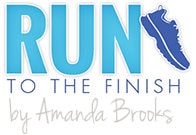
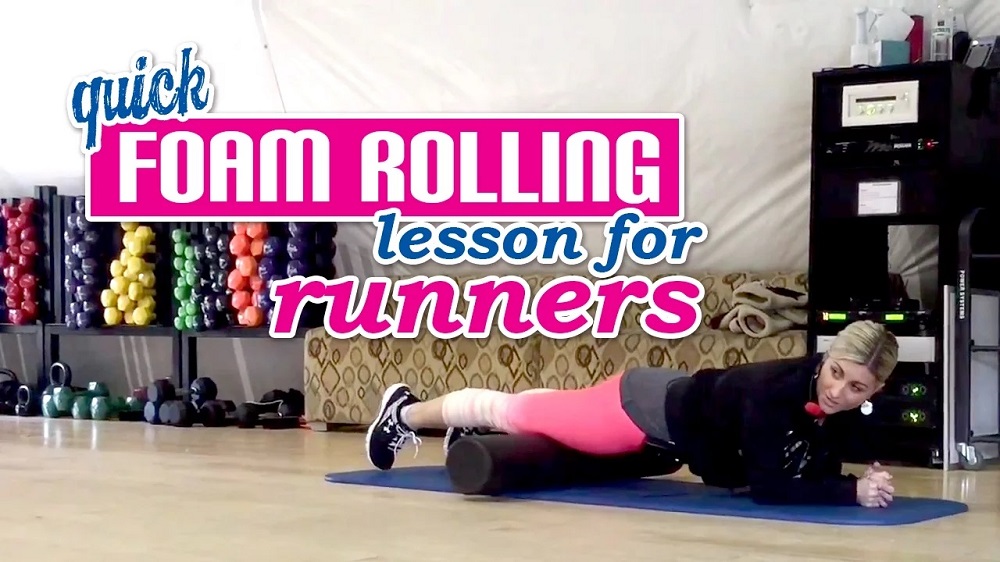
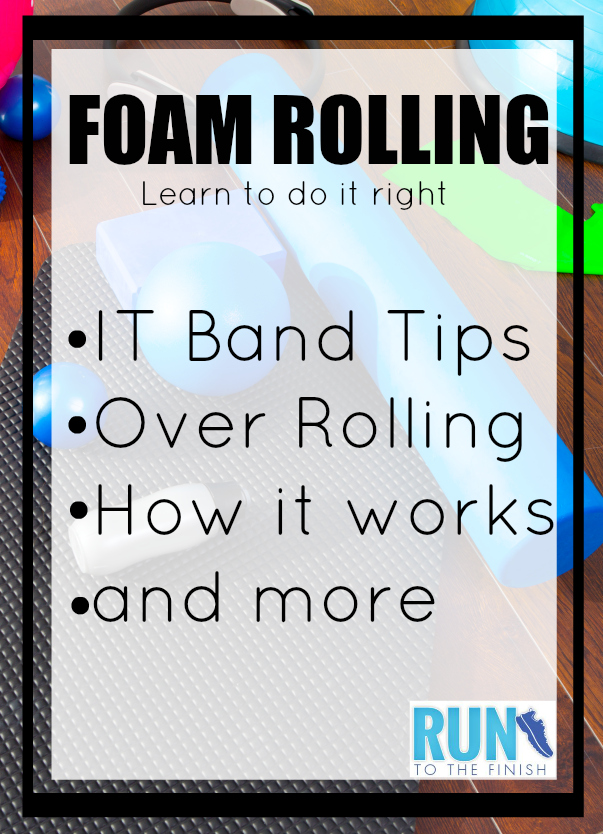
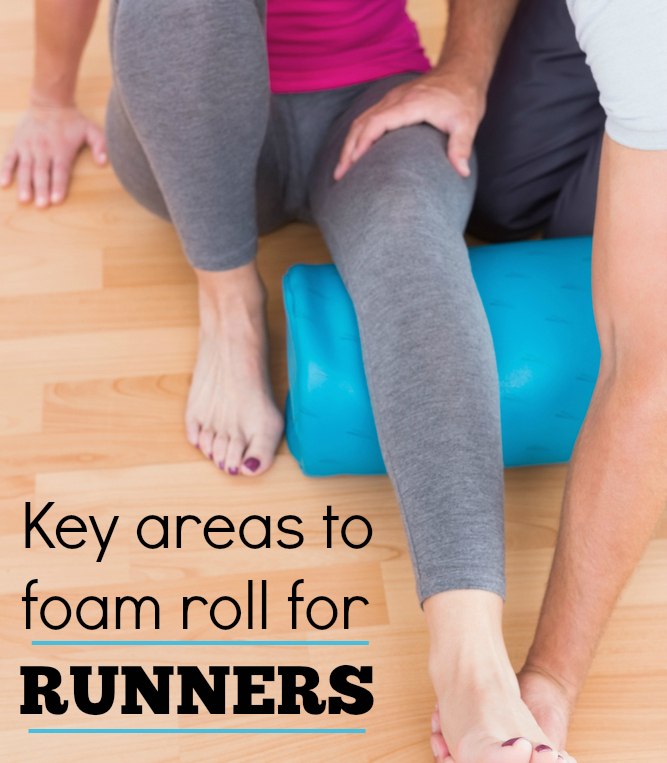
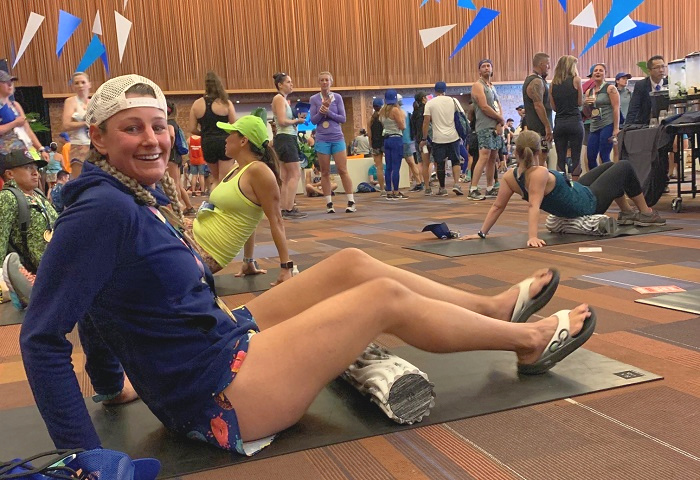
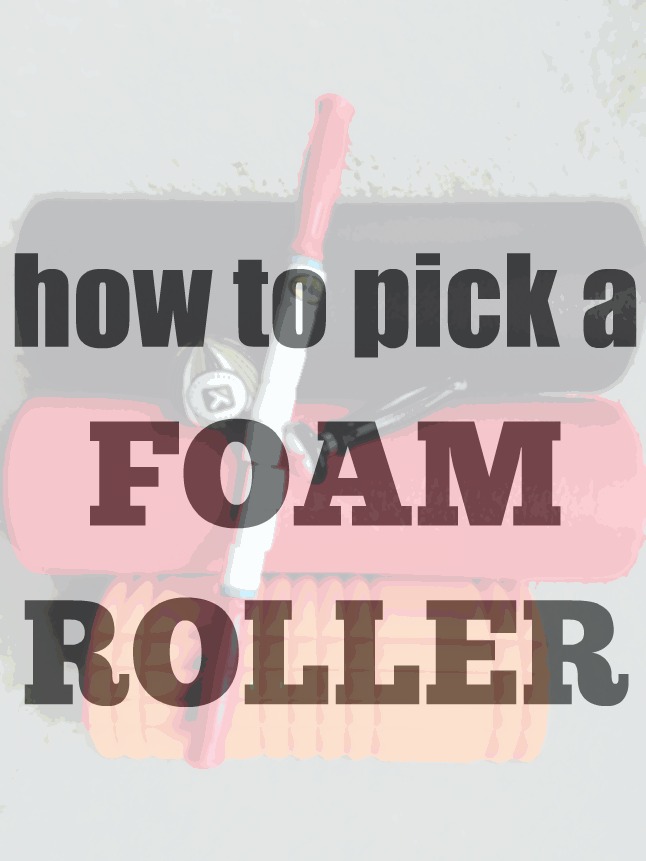
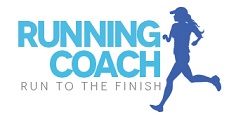
 27 Running Fuel Alternatives to Gels (Sensitive Stomach Ideas)
27 Running Fuel Alternatives to Gels (Sensitive Stomach Ideas)
Kaelee
I have never tried rolling my inner thigh, but I can only imagine how badly it needs it! Definitely need to pick up a massage stick!
andy atari
To me, foam rolling is a great way to relieve muscle soreness and tension. It’s a bit painful, (torturous, actually) but that’s part of the process of releasing the pain. I feel much more relaxed and much less tense after rolling.
Andy
i love rolling my calves on a foam roller with a trigger point or any type of roller that has ledges so that the intensity changes within my calves. It hurts alot more than I thought though!